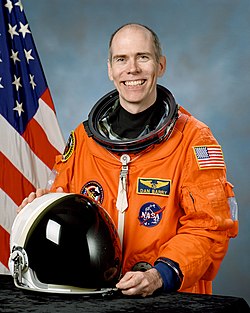Daniel Thomas Barry
| Daniel Thomas Barry | |
|---|---|
 Daniel Thomas Barry | |
| Astronaut NASA | |
| Státní příslušnost | |
| Datum narození | 30. prosince 1953 (68 let) |
| Místo narození | Norwalk, Connecticut |
| Předchozí zaměstnání | vyučující profesor |
| Čas ve vesmíru | 30 dní, 14 hodin a 27 minut |
| Kosmonaut od | 1992 |
| Mise | STS-72, STS-96, STS-105 |
| Znaky misí | |
| Kosmonaut do | 2005 |
| Pozdější zaměstnání | důchodce |
| Některá data mohou pocházet z datové položky. | |
Daniel Thomas Barry (*30. prosince 1953 v Norwalku, stát Connecticut, USA), vyučující profesor a americký kosmonaut. Ve vesmíru byl třikrát.
Život
Studium a zaměstnání
Absolvoval střední školu Bolton High School. Bakalářské studium na Cornell University zdárně zakončil v roce 1975 a pak pokračoval ve studiu na Princeton University. Zda získal v roce 1980 doktorát filozofie. Další dva roky strávil výukou na University of Miami, kde získal doktorát z oboru lékařství. Po ukončení škol učil na University of Michigan
V letech 1992 až 1993 absolvoval výcvik u NASA, od roku 1993 byl zařazen do jednotky kosmonautů. Zůstal v ní až do roku 2005, pak byl vedoucím pracovníkem v společnosti Denbar Robotict.
Lety do vesmíru
Na oběžnou dráhu se v raketoplánech dostal třikrát ve funkci letového specialisty a strávil ve vesmíru 30 dní, 14 hodin a 27 minut. Absolvoval také 4 výstupy do volného vesmíru (EVA), při nichž strávil ve skafandru 26 hodin a 26 minut. Byl 330. člověkem ve vesmíru.
- STS-72 Endeavour (11. leden 1996 – 20. leden 1996)
- STS-96 Discovery (27. květen 1999 – 6. červen 1999)
- STS-105 Discovery (10. srpen 2001 – 22. srpen 2001)
Kdo přežije
V roce 2005 se zúčastnil 12. série reality show Kdo přežije. Tato řada se vysílala od 2. února 2006 na CBS jako Kdo přežije: Panama.
Dan byl v rozdělení podle věku a pohlaví zařazen do kmene starších mužů. Vyřazen byl 15. den jako šestý a poslední člověk před sloučením kmenů. Ze 16 soutěžících se tedy umístil na 11. místě.
Odkazy
Externí odkazy
 Obrázky, zvuky či videa k tématu Daniel Thomas Barry na Wikimedia Commons
Obrázky, zvuky či videa k tématu Daniel Thomas Barry na Wikimedia Commons - Na webu Space
- Na webu MEK-Kosmo
Média použitá na této stránce
The STS-105 crew patch symbolizes the exchange of the Expedition Two and Expedition Three crews aboard the International Space Station. The three gold stars near the ascending Orbiter represent the U.S. commanded Expedition Three crew as they journey into space, while the two gold stars near the descending Orbiter represent the Russian commanded Expedition Two crew and their return to Earth. The plumes of each Orbiter represent the flags of the United States and Russia and symbolize the close cooperation between the two countries. The Astronaut Office symbol, a star with three rays of light, depicts the unbroken link between Earth and the newest and brightest star on the horizon, the International Space Station (ISS). The ascending and descending Orbiters form a circle that represents both the crew rotation and the continuous presence in space aboard the ISS. The names of the four astronauts who will crew Discovery are shown along the border of the patch. The names of the Expedition Three and Expedition Two crews are shown on the chevron at the bottom of the patch. The NASA insignia design for Shuttle flights is reserved for use by the astronauts and for other official use as the NASA Administrator may authorize. Public availability has been approved only in the form of illustrations by the various news media. When and if there is any change in this policy, which we do not anticipate, it will be publicly announced.
Designed by the crew members, this is the mission insignia for the STS-96 space flight, the second Space Shuttle mission dedicated to the assembly of the International Space Station (ISS). The crew patch highlights the major themes of the Station Program: Earth-directed research, the advancement of human space exploration, and international cooperation. The Space Shuttle Discovery is depicted shortly after reaching orbit as the crew prepares to carry out the first docking with the new Station. At this early stage in its construction, ISS consists of two modules: Zarya and Unity, shown orbiting Earth. The triangular shape of the patch represents building on the knowledge and experience of earlier missions, while the three vertical bars of the astronaut emblem point toward future human endeavors in space. The five-pointed star that tops the astronaut emblem in this depiction is symbolic of the five space agencies participating in the development of ISS: NASA, the Russian Space Agency, the European Space Agency, the National Space Development Agency of Japan, and the Canadian Space Agency. The blend of red, white, and blue is a tribute to the nationalities of the crew members who are from the United States, Canada, and Russia.
Astronaut Daniel Thomas Barry
STS-72 Mission Insignia




